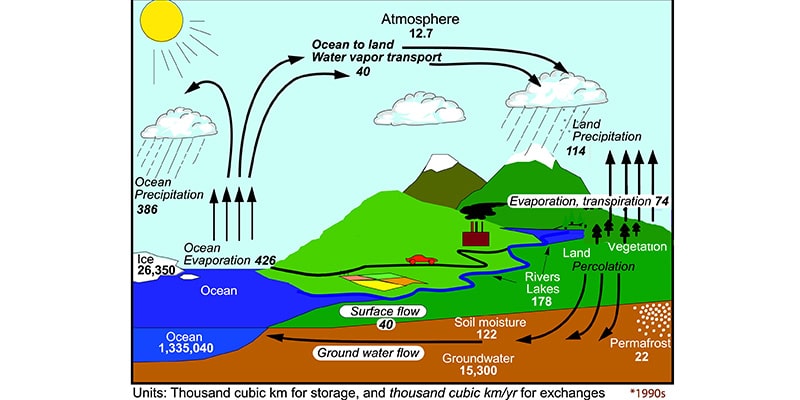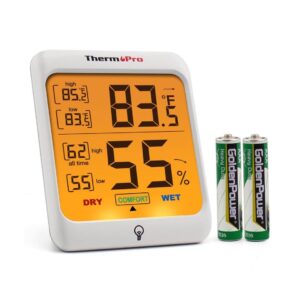The customer service team is always listening, taking notes, and quantifying complaints to ensure our products are continually improved. Due to selling directly to you, the customer, via Amazon, we can use product reviews to help us improve our existing products or help further development of new products.
Hygrometer, Humidity and Climate Relationship
Table of Contents
Whether it is in the Earth’s atmosphere or a terrarium for plant and/or animals; humidity and temperature play a critical role in the environment. How the two of these interact to decide how moist the environment may be, the temperature, and the overall health of living things. Air temperatures change and affect the ability of the air to hold water vapor. Dew point and humidity are components that aid in describing how the weather is affected.
To be able to measure these values, a hygrometer is necessary. This is an instrument that can measure the humidity and water vapors in the atmosphere, soil, or other enclosed areas. Now for the bigger question, how is all this related?
How Temperature & Humidity are Related?
Temperature and humidity affect one another. When air temperatures change, it allows for the atmosphere to open and increases the amounts of water vapor the air will hold. In simple terms, humidity is the amount of water vapor the air contains. Humidity is a critical player in what temperatures feel like to the environment. An example of this is if the actual temperature is 75 degrees, but there is 0 percent of humidity in the air, then the temperature will feel like 69 degrees.
The temperature and humidity relationship also affect the body and how it works. The body uses air temperature to decide how to keep warmer or cooler. Depending on the humidity, mechanisms such as sweating do not work effectively. Low humidity, even when temperatures are higher, causes sweating to be more effective. As the body sweats, it evaporates into the air quicker and keeps the body cooler. When the humidity is high, and temperatures are high then sweating is increased and is less effective because it cannot evaporate as quickly with the extra moisture already in the air.
Relative vs. Absolute Humidity – What’s the Difference?

Absolute humidity is the measure of water in the air regardless of the temperature. The amount of moisture in the air is expressed using grams of moisture per cubic meter of air (g/m3). If the temperature of the air is 86 degrees, then the maximum absolute humidity is approximately 30 grams of water vapor.
When discussing relative, it is different. Relative is expressed as a ratio of the partial pressure of water vapor to the equilibrium vapor pressure at a given temperature. Dependent on the temperature and the pressure of the system, the humidity will have variances. When the air is cooler there is a higher humidity than if the air is warm.
If describing climates in enclosed spaces such as buildings or cars the climate is controlled for comfort, health, and safety. This is for the people who are in the area as well as any machines or equipment that must be kept in a certain climate to function at their full capability. The humidity and temperature are controlled to keep these environments as they should be. Heating and air units that are building used to keep the environment warm or cold are designed to keep the humidity and temperatures within a certain range. For an air-conditioned building, relative humidity will be kept between 30 to 60 percent so that the temperature can be maintained at a comfortable level around 70 degrees.
Relative does not have much effect on humans for thermal comfort. Humans are more susceptible to temperature variations than the variances that humidity may contain. Although this is not as true when comparing outside to inside humidity. Low humidity indoors can cause discomfort. Dry air leads to dry skin, dry nasal passages, and makes us more susceptible to illnesses. This issue is often the reason doctors recommend using humidifiers in bedrooms. A humidifier puts moisture back into the air and aids in keeping us healthier.
When comparing relative to absolute humidity, they both measure water vapor. However, it is relative that plays a more significant role in deciding how the environment reacts to the humidity based on the temperature of the air. This reaction between moisture in the air and the temperature is what determines how we as humans or animals feel in the environment. It is also what determines the effects the environment has on plants absorbing water and their development.
Does humidity increase after rain?

Rain does play a significant role in humidity increasing. This is referring back to relative humidity. Moist air decreases by cooling and will increase by heating when water vapor is not added or removed from the air. When hot and unsaturated humid air rises into the atmosphere the air is slightly cooled as it moves up. It is at this point condensation begins to develop. As condensation grows and overflows the drops fall in the form of rain. The rain will stop once the air becomes saturated by the remaining amount of water vapor. The humidity is increased due to the moisture holding capacity of the air decreased from the rain as a part of evaporation. On a small scale, the evaporation cools the air and increases the absolute moisture content of the area. Looking at a larger scale rain will remove water vapor from the air through condensation and deposit it on the surface, where it will often re-evaporate. This will reduce the average humidity in the area.
Does heating air remove humidity?
This answer will vary depending on the type of humidity that is being discussed. When discussing absolute humidity, the short answer is that heating the air will not remove humidity. The water vapor in the air will remain. When talking about relative humidity, the short answer is yes, but there are some clarifications about the changes to the air and surrounding environment that factor into this answer. Adding heat will allow the air to be able to hold on to more humidity. Heating the air may not remove humidity, but it will make the air feel less humid. By heating the air and increasing its ability to hold water vapor, it will lower the humidity of the air.
Are all hygrometers relatively accurate?

Hygrometers are not made to measure absolute humidity but relative. They are designed to measure the ambient air moisture in a percent. The device is useful when trying to keep an environment within a specific range for optimum health. In general humidity measurement devices are relatively accurate. There are some instances where one brand may not be as accurate as another. However, they will fall close to the same accuracy. Some devices will measure to the 5 percent so this type of device may not show the same accuracy as one that measures to the 1 percent. Some other variances may be found between digital devices and ones that are a disc with a pointer. It is easier to accurately read a digital display rather than a dial display.
Overall, humidity measuring devices are relatively accurate and useful to have in different environments. The humidity readings can be used to keep optimum humidity levels in an environment. This can provide the ability to control humidity and improve living situations for health or comfort.
To summarize, understanding humidity and its effects on the environment not only helps when trying to understand how weather works, but it aids in being able to provide one’s self with an optimum living environment. It is also possible to explain the uses of changing humidity or temperature to get optimum environment situations. The changes in climate come from the changes in temperature and moisture vapors within the air. This is how rain and snow are formed and fall from the atmosphere. Temperature and humidity are the starting point for how weather works. It aids in the explanation of global warming and other trends that have changed how the climate is affected. The drastic changes in temperature cause rain, snow, wind, and massive inclement weather formations that commonly affect our day to day lives. Being able to measure humidity in enclosed environments not only make it possible to keep environments more comfortable, but to be able to ward against ailments that make people sick and uncomfortable.
-
ThermoPro TP53 Digital Hygrometer Indoor Thermometer for Home
$13.99 $13.99Rated 4.65 out of 5Add to cart










